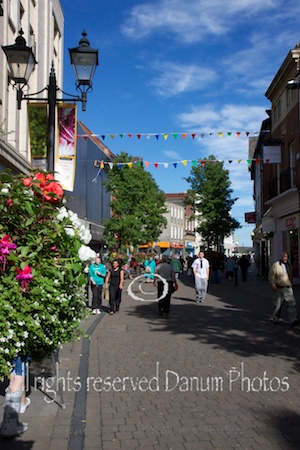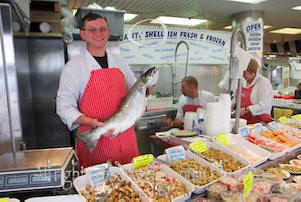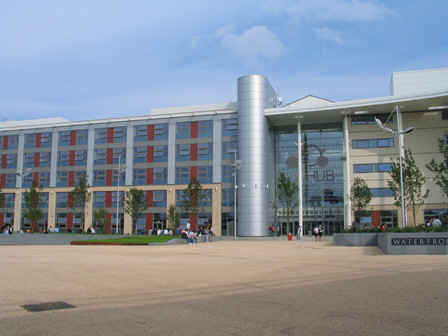|
Doncaster is a town in South Yorkshire, England and the principal settlement
of the Metropolitan Borough of Doncaster. The town is located approximately
twenty miles from Sheffield and is popularly referred to by some of its
residents as Donny.
<<
Purchase Photos of Doncaster >>
Doncaster, home of the world's oldest classic horse race
"The St Leger"
Doncaster has a new International airport and its centre has undergone
regeneration including the development of an Education City campus, currently
the largest education investment of its kind in the UK. Doncaster has also
recently extended the Frenchgate Centre, a shopping centre and transport
interchange.
According to the 2001 census the urban sub-area of Doncaster had a population of
67,977 - together with Bentley, Armthorpe and Kirk Sandall it forms an urban
area with a population of 127,851. The wider Metropolitan Borough has a
population of 286,866.
[ Cusworth Hall ] [ Conisbrough Castle ] [ Custom Car Show 2007 ] [ Museum & Art Gallery ] [ St George's Minster ] [ Racing ] [ St Leger 2010 ] [ Doncaster Races ] [ Doncaster Waites ] [ Doncaster Photos ] [ Education City ] [ Lakeside ] [ Doncaster Robin Hood ] [ Green Oak Morris Men ] [ Bloodstock Sales ] [ Mansion House ] [ Old Doncaster ] [ Bentley Floods ] [ Dragon Boat Race 2010 ] [ Doncaster Markets ] [ Doncaster Continental Market ] [ Doncaster Town Centre ] [ Doncaster Performance Centre ] [ Doncaser Jazz Festival ]
Doncaster St George's Minster

Doncaster Town Centre

Roman History
Doncaster (or DANUM as called during Roman times) is located at the site of a
Roman fort which was built in the 1st century A.D. at the site of a crossing
across the River Don. The Roman empirical command of Ninius called this fort "Caer
Daun". Later the commands of Antoninus Pius and Notitia called this fort Danum,
from which the town derives the Don part of its name; caster was from the Roman
word for "fort". Doncaster was home to the Roman Crispinian horse garrison. The
cavalry took its name from Crispus, son of Constantine the Great. Crispus, son
of the Emperor, lived at Danum (Doncaster) whilst his father lived 40 miles
further north at Eboracum (York). Much of Doncaster's Roman past remains to be
discovered.
The name 'Danum' is used for many local business ventures
and indeed for the name of this website.

Doncaster Markets
Doncaster provided an alternative direct land route between Lincoln and York.
The main route between Lincoln and York was in fact Ermine Street which meant
crossing the River Humber in boats. For obvious reasons this was not always
practical and thus Doncaster became an important staging post on the Roman map.
Early and Medieval History
The town was rebuilt by the Normans after William I took the throne. The Normans
also built a castle at nearby Conisbrough.
As the 12th century approached, Doncaster matured into a busy town and in 1194
King Richard I granted Doncaster national recognition with a Royal Charter.
During the Middle Ages Doncaster evolved further and it was then later in 1204
that Doncaster suffered and recovered from a disastrous fire. At this time,
buildings were built of wood and fire was a constant hazard.
In 1248, a charter was granted for Doncaster Market and some 750 years on, the
market still exists with its busy stalls located both outside and under cover.
The market also occupies the 19th Century 'Corn Exchange' Building, opened in
1873[2] and extensively rebuilt in 1996 after a major fire.
Today, many Doncaster streets are named 'gate'. The word 'gate' is derived from
the old Danish word 'gata' which meant street. During Medieval times, craftsmen
or tradesmen with similar skills, tended to live in the same street. Baxter is
an ancient word for baker thereby confirming that Baxtergate was indeed the
baker's street. It is assumed that 'Frenchgate' may be named after French
speaking Normans who settled on this street.
.jpg)
Doncaster Hub

The medieval township of Doncaster is known to have been protected by earthen
ramparts and ditches leaving four substantial gates as entrances to the Town.
These gates were located at Hall Gate, St Mary's Bridge (old), St Sepulchre Gate
and Sunny Bar. Today the gates at Sunny Bar are commemorated by huge 'Boar
Gates', similarly, the entrance to St Sepulchre Gate is also commemorated, this
time with white marble 'Roman Gates'. The boundary of the Town principally
extended from the River Don, along what is now, Market Road, Silver Street,
Cleveland Street and Printing Office Street.
During the 14th century numbers of friars arrived in Doncaster who were known
for their religious enthusiasm and preachings. In 1307 Franciscan friars arrived
and they were called grey friars because of the colour of their costumes.
Carmelites or white friars arrived in the middle of the 14th century.
During the 16th and 17th centuries the town of Doncaster continued to expand.
This was despite several outbreaks of plague from 1562 until 1606. Each time the
plague struck down significant numbers of Doncaster's population.
<<
Purchase Photos of Doncaster >>
below - Doncaster Waterfront
.JPG)
Continuing the Industrial Revolution, the railway came to Doncaster, and the
Great Northern Railway Locomotive and Carriage Building Works was established
there. The reasons for this were due to Doncaster's communication links, the
necessity to transport coal quickly and efficiently and Doncaster's expertise in
specialist metal products. An extensive housing programme was undertaken to
cater for the increase in the population. The Chairman of the Great Northern,
anxious about their spiritual welfare, persuaded the directors to contribute
towards the building of St. James' Church, which became known as the "Plant
Church". The railway also built St. James' School. The Doncaster Plant became
famous for building LNER 4-6-2 locomotives Mallard and the Flying Scotsman, as
well as many thousands more locomotives. Today, the town retains a key station
on the East Coast line. Many destinations can be reached by rail from Doncaster.
<<
Purchase Photos of Doncaster >>
Due to its proximity to major urban centres and motorway/rail infrastructure,
Doncaster is home to a number or major distribution centres. These include an
International Rail Freight Centre at Black Bank where freight is transported to
Europe by rail. Huge warehousing & logistic capabilities for retailers such as
Tesco, Ikea, Exel & Faberge also exist. One location in particular is the B&Q
Distribution Centre at Redhouse A1(M) Junction 38 which was the largest
freestanding warehouse in the UK until Dixons Group opened a second warehouse on
their Newark site at the side of the A1 30 miles to the south of Doncaster. A
significant proportion of fresh and frozen goods for Northern Supermarkets are
dispatched by road from here.
On March 5, 2004, Doncaster was granted Fairtrade Town status
<<
Purchase Photos of Doncaster >>
clients of our Doncaster Photos have included 'The Dalesman',
Webasto Product UK Ltd, Flame Tree Publishing 2008 Doncaster Calendar, Foy's
Solicitors, SJP Marketing Bawtry, Creative Studio Property and Corporate
Services Deloitte & Touche LLP, Aylesworth Fleming Ltd, Andy Reed - Hambleton,
Handlesbanken Doncaster, Auckley Arrow,
see more of our photos - follow the links below
[ Cusworth Hall ] [ Conisbrough Castle ] [ Custom Car Show 2007 ] [ Museum & Art Gallery ] [ St George's Minster ] [ Racing ] [ St Leger 2010 ] [ Doncaster Races ] [ Doncaster Waites ] [ Doncaster Photos ] [ Education City ] [ Lakeside ] [ Doncaster Robin Hood ] [ Green Oak Morris Men ] [ Bloodstock Sales ] [ Mansion House ] [ Old Doncaster ] [ Bentley Floods ] [ Dragon Boat Race 2010 ] [ Doncaster Markets ] [ Doncaster Continental Market ] [ Doncaster Town Centre ] [ Doncaster Performance Centre ] [ Doncaser Jazz Festival ]
information from Wikipedia
|